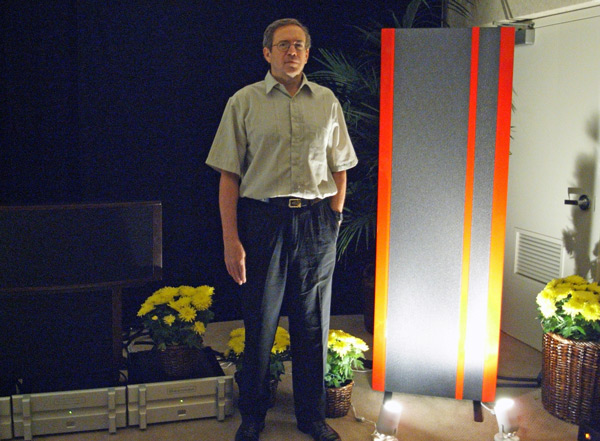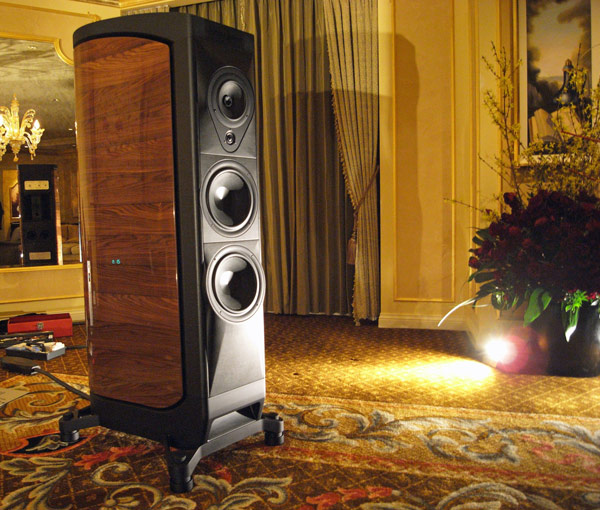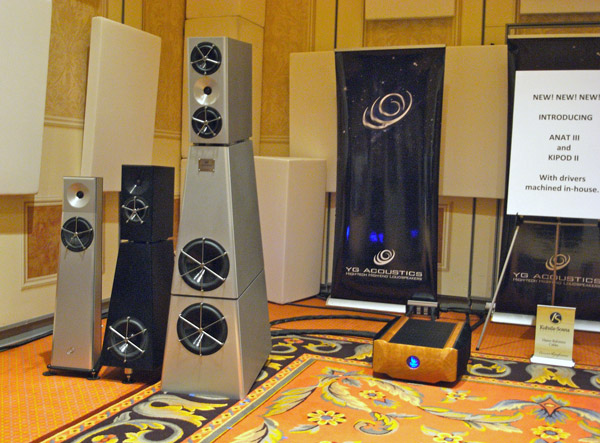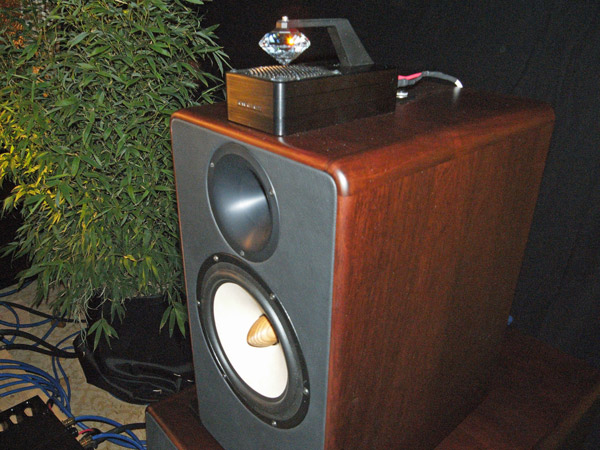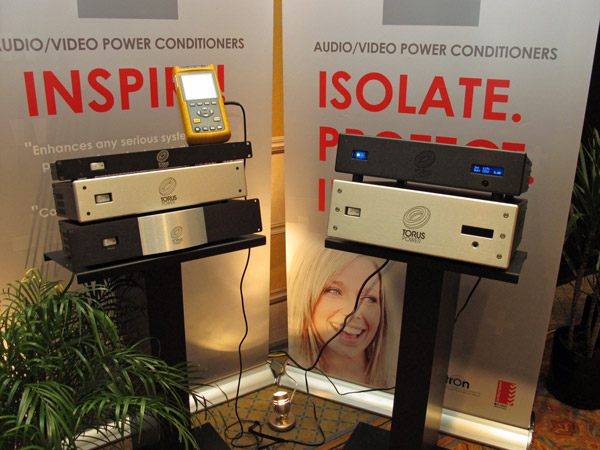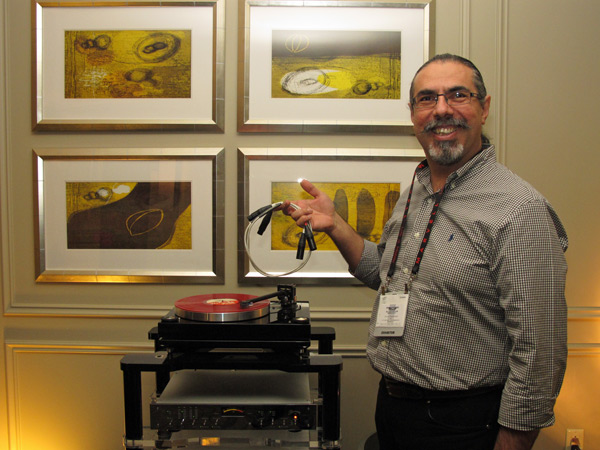LATEST ADDITIONS
The Sonus Faber
This is a big speakerit stands 67" tall and weighs 672 lbsand was being demmed in an appropriately large room with the large Audio Research Reference 610T tubed monoblocks. Or it would have been demmed, as on both my visits to the room, the electricity supply to the room had failed. (If you look closely, you can see the electrician's red toolbox to the left of my photo.)
Sonus Faber Amati Futura
Major Changes for YG Acoustics
Called "BilletCore" by the Colorado company, the aluminum cone for the midrange and low-frequency drive-units used in the top-of-the-line Anat III Reference ($111,000/system) and the smaller three-way Kipod is milled from a solid block of aluminum. In the case of the Anat subwoofer, the starting point is a billet of aluminum 2.5" thick weighing 16 lbs, compared with the finished cone after a day of work, which is 0.008" thick and weighs less than 1 ounce. Stiffening ribs are left on the rear of the cone and the final step is to black-anodize the aluminum. The benefit of machining the cone is said to be improved unit-unit consistency and rigidity compared with a conventional spun, cast, or pressed metal diaphragm, which pushes break-up modes even farther out-of-band.
Though YG was in the same room as in previous CESes, they had taken heroic measures this year to tame its acoustics, as can be seen from the photo. The result was worth the effort. In a system that included dCS Scarlatti digital front-end, a Veloce battery-powered preamp, Tenor 350M monoblocks, and Kubala-Sosna Master Reference cables, the Anat II Reference produced a warm, detailed, full-range sound. Particularly impressive was a version of Sting's "Roxanne" from Italian singer Petra Magoni of Musica Nuda. Both the voice and the solo double bass accompaniment had a palpable presence but without sounding forced or exaggerated.
Trenner & Friedl Duke
Each 12" woofer uses a fiber-glassreinforced paper cone and is loaded by what is referred to as "a hybrid form of horn-resonator and bass reflex design." The mid/HF module is coupled to the woofer modules with spheres of varying hardness, to drain vibrations optimally, and can be adjusted to bring the drivers into proper time alignment at the listening position. The midrange unit features a papyrus cone with an elmwood phase plug and an alnico magnet, while the enclosure is filled with wool from "locally raised sheep" to reduce internal reflections being retransmitted through the drive-unit cone. The tweeter uses a titanium nitride dome loaded with a Tractrix-flare horn, while the supertweeter is a diamond-diaphragm type. The upper-range crossover is passive; the woofers are fed via a line-level crossover, and internal wiring is all Cardas Clear.
Trenner & Friedl's Crystal Power
Gutwire's Good Cables
“We find copper is more natural and musical-sounding,” Herbert explained.
The photo shows the newest additions to Gutwire’s cable line. The power cable is the SP Crystal Edition AC cable ($1800/6ft), which lies in the middle of their price spread. Also shown are the EON-Z interconnect ($1600/1m pair) and UNO-S interconnect ($2500/1m pair). By way of comparison, the prices of the company’s top-of-the-line are as follows: the SP-18.1 AC cable ($7500/6ft), Uno-S interconnects ($2500/1m pair), and digital SD-3-SE ($1150/1m).
The terminations on Gutwire’s novel top-of-the-line SP cabling contain Bincho-Tan (white charcoal). Bincho-Tan emits negative ions, absorbs RF and EMI. Herbert first discovered the substance in his water purifier. Intrigued, he began to research it on the net, and learned about its other properties.
Gutwire also manufactures two 4 and 6 outlet power conditioners, the 4 Bar and 6 Bar ($1100$2600, depending upon the model). Each contains a passive filter, and the top of each is milled from a block of solid aluminum.
In a brief demo, I was struck by Gutwire’s ability to transmit a lovely smooth midrange on the classic recording of Harry Belafonte at Carnegie Hall.
Torus Power from Plitron
Arthur Kelm, formerly chief engineer in a number of recording studios including Record One, the Record Plant, and Skywalker, designed the Torus Power Ground One power conditioner panel that uses Plitron transformers. “I have known that power is the foundation of every audio/video system,” he explained. “It’s also the most misunderstood application you have. People just don’t understand power and its importance.
“The major advantage of using an isolation transformer is that you now have a very low impedance to plug into, and you can rebond neutral and ground which is where 90% of your noise comes from in electrical systems.”
The complete Torus Power line includes units from 2.5 amps up to 300400 amps. The lowest priced unit, the RM 2.5 ($999), handles 2.5A. The company’s most popular units, ideal for dedicated audio systems, are the RM 15 ($2000) and RM 20 ($3000). There is also a custom installation series with 60A and 100A units, plus Ground One panels for use in all-home AV and theatres. Some models include automatic voltage regulation.
TM Systems: New Name; Familiar Face
Not yet distributed in the US, Moghaddam’s handmade interconnects ($8000$9000/1.1m pair) will be followed in February or March by the machine-made Pulse R interconnects ($4000$5,000), which include special proprietary connectors made of copper alloy. Below them, Pulse B and Pulse C entry-level interconnects are in the works.
Veteran audiophiles will recognize Moghaddam as the 25-year veteran designer of Roksan turntables and loudspeakers. He began designing and manufacturing Pulse cables three years ago after he discovered that some Roksan ‘tables were being used with incompatible cables.
Gary Koh of Genesis, who had invited Moghaddam to exhibit his cables in the Genesis room, noted that they both attended the same college in England 25 years ago. “And now, 25 years later, we discover that we are both making our own cables because of similar concerns, such as their incorrect use by some people as tone controls,” he said.
Music Hall's Leland Leard
Here, however, Leland is demonstrating how to expose the old-fashioned baffle which hides behind the Epos Epic 2’s slick baffle cover.
People say that Leland and I look alike, but I don’t see the resemblance. Leland wears tighter jeans and frillier shirts, and has a much better smile.

